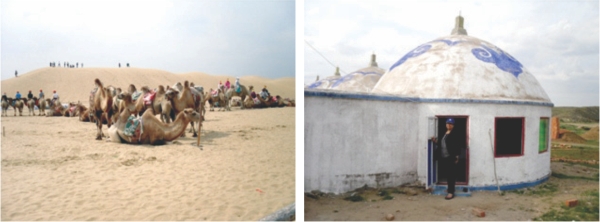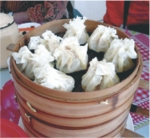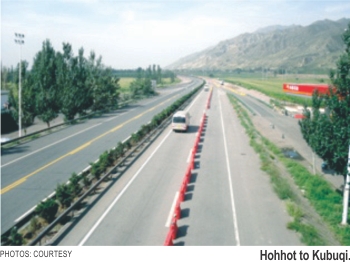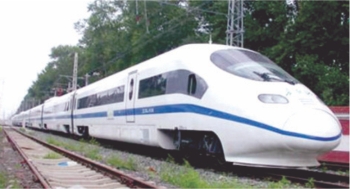| Home - Back Issues - The Team - Contact Us |
 |
| Volume 10 |Issue 37 | September 30, 2011 | |
|
|
Reflections
A trip to Hohhot, Inner Mongolia Dr Salehuddin Ahmed
The month is August, 2011. Two Bangladeshi families living in Beijing decide to make an adventure to the grasslands and deserts of Inner Mongolia. We have no idea how to go there. We find on the internet that one could take a train or plane to reach Hohhot, the Capital of Inner Mongolia. We have thought it will be good if we take the train. It is an overnight train journey. We contact a Chinese travel agent and they arrange everything including train tickets for the six of us, accommodation in the grassland, a city tour of Hohhot and a trip to the desert outside Hohhot. In China there are different types of trains. You may have heard about the fastest train in China- the C-trains. These run between big cities, such as between Beijing and Shanghai, Beijing--Tianjin, Guangzhou--Shanghai and some others. They run at an average speed of 300+ km per hour. From here to Shanghai it takes only five hours, whereas on regular trains it will be 10 hours. In overnight trains there are hard sleepers and soft sleepers. It is air-conditioned. We do not get tickets on soft sleepers, so we travel in hard sleepers. They were six sleepers in a cabin, 3-tier bunks with clean beds on each, really comfortable. We have already travelled to Xian in Soft Sleepers. Those are more comfortable, 4 in a cabin with two- tire bunks. Our K-train to Hohhot leaves Beijing at 10 p.m. and we reach Hohhot at around 7:30 am the next day. We are in one cabin, sometimes it is hard to get tickets in the same cabin, but our travel agent has made it possible. On our return trip we did not get tickets in the same cabin, but it is in the same compartment. So we have to negotiate with some of the passengers to shift and manage to be in the same cabin after all. Most of the train passengers are Chinese. The Chinese travellers are very friendly and they cooperated with us to make those changes. Our English-speaking Chinese guide, a young man in his 20's, who saw us off to the train has also helped us in our interesting negotiations. Negotiating with four passengers is simply fascinating. Everyone is kind and accommodating. We are received at the airport by a microbus with English speaking guides, a boy and a girl. From the Hohhot station we go to a small dumpling restaurant in the city to have breakfast. The dumplings, made like flowers with a mutton filling, are very tasty. Inner Mongolia is an autonomous region of China located in the North-West of Beijing, bordered to the North by the Republic of Mongolia and Russia. This is the widest and the third largest Chinese province. The area of the province is about 1.1 million square kilometres, but not very populated, having about 25 million people. Many ethnic groups live in this area, such as, Mongolian, Tibetans, Daur, Oroqen, Ewenki, Hui, Han, Korean, Manchu etc.
It takes us about two hours to reach the grasslands. While going to the grasslands from Hohhot, we have to cross mountains. We are driving through a two way 4-lane highway, but we can see new roads being built, expanding the present one. After reaching Xilamuren grasslands, it takes us half an hour through the mud road to reach our destination. We cross four 'yurt' resorts before reaching ours. Our lodge is very interesting, made in such a way that each is an individual tent-like structure with bed and bathroom inside. These are designed after the traditional nomadic tents where the horse, camel and sheep herders lived. Mongolians still use them. They are called “Yurt”. The weather at this time of the year in Inner Mongolia is very comfortable. Many tourists, mainly Chinese, travel to enjoy the beautiful surroundings of Inner Mongolia. It is not cold, not warm, but pleasantly cool. The average temperature is around 25 degrees Celcius. At night it is cooler, and you need a blanket to sleep. It is a great experience to sleep in those tent-like yurts with the vast grassland all around. What a fabulous environment! You see grasslands in four directions, all the way to the horizons. Walking, meeting people and seeing the horses, sheep and camels is a unique experience. We also take part in their cultural celebrations, such as horse riding, dancing and singing, eating sheep roast, wrestling competition etc. Everything is colourful and great fun. In the evening children play hide and seek (blindfolded), like our “kanamachhi”. We have Orthi, the other family's 10-year-old daughter. Orthi and the Chinese children become very good friends. They loved to play with Orthi and talk to her to know more about Bangladeshi people and culture.
The most striking sights, however are seeing the sunset and sunrise in the grasslands. It is hard to explain. The colours during the sunset and sunrise are simply gorgeous. A person who has never written poems, could write one in that serene environment. There are many people who gather to witness the sunrise capturing the moment in their camera. Early in the morning the next day, we begin our journey to the desert. It is in another direction and the travel time by microbus is about five hours. We go through an arduous journey, but the 4-lane highways are smooth and the ride is comfortable. We see the country side, and also stop at the Service Centre to have some food and drinks. We are in the desert for about two hours. The Kubuqi (pronounced Kubuchhi) desert, south of Yellow river, is not very impressive. It is a big expanse of sand and sand dunes. The temperature is not very high, quite tolerable. That is the good part of it, but it is a bit too commercialised and there are too many people. You could feel that China is a really populated country. But we enjoy our time overall. The mutton kebabs we eat are really tasty. From the desert after a three hour ride we come back to Hohhot to catch our K-Train to Beijing. The train leaves at 10:30 in the evening and we are in Beijing the next day at 7:30 am. Going to Inner Mongolia has been a grand experience, to say the least. We all thoroughly enjoyed it. If anybody is coming to China I would recommend that you make a trip to the grasslands of Inner Mongolia. I can assure you that you will not regret it. The writer is Chief Technical Advisor, International Poverty Reduction Centre in China.
Copyright
(R) thedailystar.net 2011 |
||||||||


 The capital city of Hohhot is a beautiful city with 36 ethnic groups and five ancient temples. Hohhot in Mongolian means “green city”. In Chinese they pronounce it as “Huhehaote”. The city covers an area of 17,224 square kilometers with a population of about 1.5 million.
The capital city of Hohhot is a beautiful city with 36 ethnic groups and five ancient temples. Hohhot in Mongolian means “green city”. In Chinese they pronounce it as “Huhehaote”. The city covers an area of 17,224 square kilometers with a population of about 1.5 million.